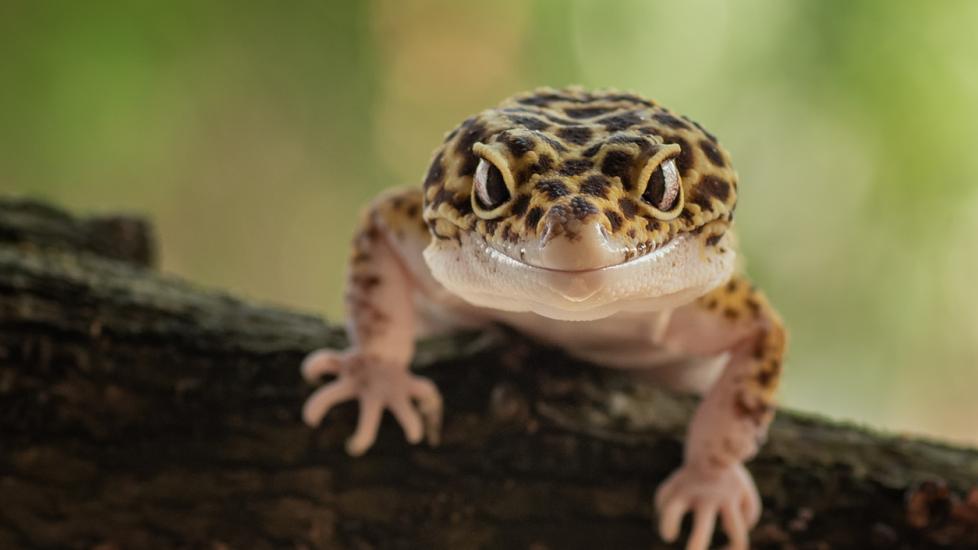Leopard Geckos: All You Need to Know
Leopard geckos are an excellent beginner reptile for any pet parent. This species is native to the deserts of Afghanistan, India, and Pakistan. Geckos are a nocturnal species, and are known for being gentle, hardy, and can live upwards of 25 years in captivity. All of these traits make them popular as pets and an excellent choice for a companion.
Leopard Gecko Housing
Leopard geckos can be successfully housed as juveniles within a 10-gallon aquarium and can transition into a 20-gallon enclosure as they grow. Geckos are terrestrial and can benefit from a large amount of floor space rather than vertical space. The floor space should be easy to clean and made of a substance that your leopard cannot ingest. Items to use can include:
-
Paper towels
-
Newspaper
-
Reptile carpet or tile
-
Sand or bark is not recommended
It’s important to provide an appropriate range of temperatures within the enclosure. The cool end of the enclosure should stand at 73-75 degrees F and between 88-90 degrees F on the warm end of the habitat. Water should be always provided for leopard geckos.
There are two ways to provide heat for your leopard gecko:
-
Overhead ceramic heat emitters or incandescent bulbs
-
Never use a hot rock or let your leopard gecko come into contact with a heating element or light.
In the wild, leopard geckos love to shelter underneath rocks and within burrows. Providing shelters within their environment will help enrich their lives. It’s great to provide multiple “hide boxes” on both sides of the enclosure to help mimic their natural environment. A “humid hide box” can be filled with moist sphagnum moss, vermiculite, or a sponge to provide an area of humidity (this should be changed regularly).
Recently it has been recommended to provide some ultraviolet exposure to leopard geckos because it can help with calcium absorption and their immune function.
Shop Popular Reptile Products
Foods for Leopard Geckos
Leopard geckos consume live insect prey items including:
-
Farmed crickets
-
Mealworms
-
Superworms
-
Waxworms
-
Silkworms
-
Dubia roaches
-
Other insects
Insects should not be fed when caught from the wild as some may be toxic. All the above prey insects need to be “gut loaded” prior to feeding leopard geckos, as many insects are not nutritionally complete.
Gut loading can be done by feeding the insects a nutritious diet 6-12 hours before feeding your leopard gecko any insects. Insects fed to leopard geckos can also be supplemented with both calcium and multivitamin dusted onto the insects immediately before feeding. Often, calcium can be provided in a small bowl within the habitat for this species to voluntarily eat. Discuss supplementation and gut loading with your veterinarian to determine the best feeding plan.
Leopard geckos can be fed food items that are appropriately sized every one to two days when they are juveniles and then three times a week when they are adults. Insects should be no greater than the length of the gecko’s head and half the width. If the prey item is not consumed within 10-15 minutes of placing it in the enclosure, then it should be removed to prevent any harm to your pet. Live prey can be offered in a shallow bowl.
Leopard Gecko Medical Needs
It is important to establish a relationship with a veterinarian that has experience with reptiles to help guide you through the essentials. They can provide routine health checks and prevent any major diseases so you can have a long relationship with your leopard gecko.
Some signs of health issues in leopard geckos include:
-
Weight loss
-
Skinny tails
-
Decreased appetite
-
Problems shedding
-
Swollen abdomen
-
Swollen eyes
Some of the most common medical disorders include:
-
Metabolic bone diseases
-
Diarrhea
-
Egg binding
-
Sand impactions
-
Shedding issues
-
Toe loss
-
Tail loss
-
Low vitamin A
-
Mouth infections (stomatitis)
-
Eye inflammation
-
Infections
Leopard geckos do not transmit any known diseases to humans.
Leopard Gecko Cleaning Needs
Food and water dishes should be cleaned daily. Often, leopard geckos will defecate and deposit urates (urine) in the same location, so it is generally easy to clean their enclosure. Spot-cleaning can be performed weekly to biweekly. A deep clean of the enclosure should be performed monthly.
Dawn dish soap or a dilute bleach (1:32 ratio of bleach to water) can be used for cleaning an enclosure. Always clean the enclosure with water following disinfection so there are no residues left over.
Leopard Gecko Handling
When handling your leopard gecko, the body should be fully supported. These geckos are unlike other gecko species that can climb onto surfaces. They do not have sticky toe pads so they are unable to cling to any surface, requiring support at all times.
Leopard geckos can drop their tails. They use this ability in the wild as an anti-predator defense. To prevent this from happening with your domesticated gecko, never grab a gecko by the tail. If a leopard gecko does drop its tail, it will move around like a worm for a bit. The gecko will heal on its own and a new tail will regenerate, however it will have a different appearance than the original tail.
Always wash your hands following any handling of your leopard gecko to prevent the transmission of bacteria such as salmonella. Most reptiles including leopard geckos carry salmonella bacteria within their intestines and shed this bacteria in their feces.
It’s important to always practice good hygiene with leopard geckos. Very young children and those that have compromised immune systems should not have leopard geckos as pets for their own safety.
References
McLaughlin A and Strunk A. Companion animal care guide. How to keep your leopard gecko healthy, happy and safe. North American Veterinary Community. 2016.
Featured Image: iStock.com/DikkyOesin
